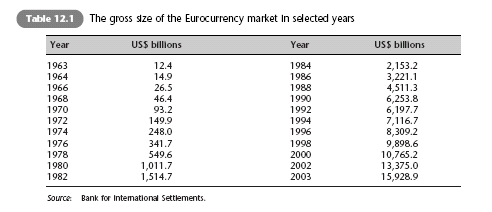


Are you sure you want to reset the form?
Your mail has been sent successfully
Are you sure you want to remove the alert?
Your session is about to expire! You will be signed out in
Do you wish to stay signed in?
In this chapter we take a detailed look at two important markets that exert a great deal of influence on the international financial system, the Eurocurrency market and the Eurobond market.

Eurocurrency markets are defined as banking markets which involve short-term borrowing and lending conducted outside of the legal jurisdiction of the authorities of the currency that is used. For example, Eurodollar deposits are dollar deposits held in London and Paris. The Eurocurrency market has two sides to it; the receipt of deposits and the loaning out of those deposits. By far the most important Eurocurrency is the Eurodollar which currently accounts for approximately 60–65% of all Eurocurrency activity, followed by the Euroeuro, Eurofrancs (Swiss), Eurosterling and Euroyen. The use of the prefix Euro is somewhat misleading because dollar deposits held by banks in Hong Kong or Tokyo are equally outside the legal jurisdiction of the US authorities and also constitute Eurodollar deposits. This more widespread geographical base means that Euromarkets are often referred to as ‘offshore’ markets.
Since the 1960s there has been an astonishing rate of growth of the Eurocurrency market (see Table 12.1). In 1963 the gross total value of Eurobank assets (a similar figure applies to deposit liabilities) was approximately $12.4 billion, but by the end of 2003 the Eurodollar market stood at $15,929 billion, works out at an average growth rate of 19.6% per annum over the 40 years! Measuring the actual size of the Eurocurrency market presents some difficulty because a distinction needs to be made between the gross and net size of the Eurocurrency market. The gross measure includes both non-Eurobank and interbank deposits, while the net measure excludes interbank deposits. The gross measure gives an idea about the overall activity in the Euromarkets while the net measure gives a better indication concerning the ability of the Eurobanking system to create credit.
The Eurocurrency market is part of the international money market since it involves lending and borrowing for a period of less than a year. By contrast, the Eurobond market is part of the international capital market and involves lending and borrowing for a periods of more than a year. A Eurobond is a bond that is sold by a government, institution or company in a currency that is different from the country where the bond is issued. For example, a dollar bond sold in London is a dollar Eurobond and a sterling bond sold in Germany is a sterling Eurobond. Both the Eurocurrency and Eurobond markets are in many ways a phenomenon of the increasingly open world trading system. There is no reason why borrowing and lending in a given currency needs be carried out exclusively in the particular country that issues the currency.
In this chapter, we deal with the origins and reasons for the subsequent rapid growth of Eurocurrency and Eurobond markets over the last three decades. We also examine the basic functioning of these markets and their economic impact. Firstly we look at the Eurocurrency markets and then look at the Eurobond markets.

.